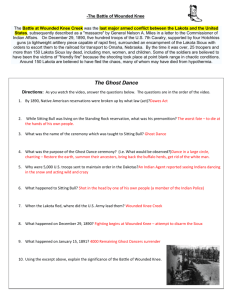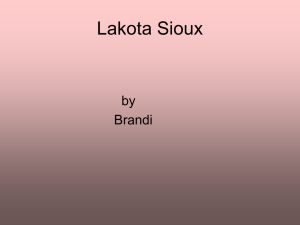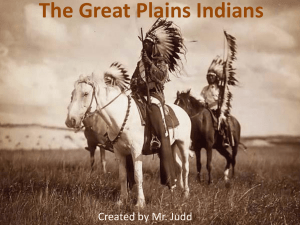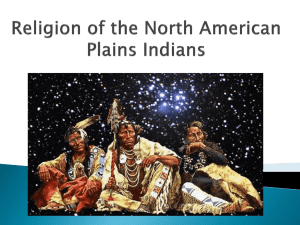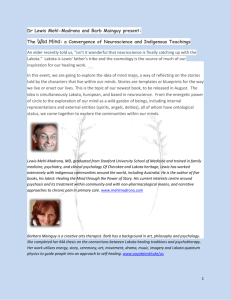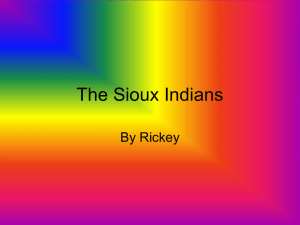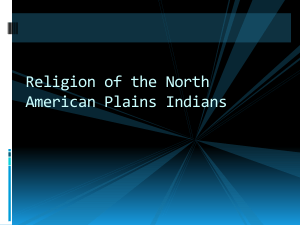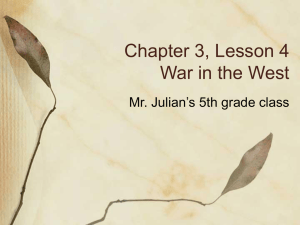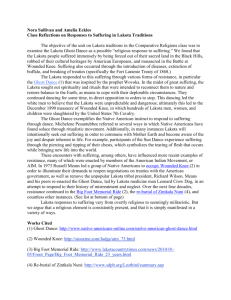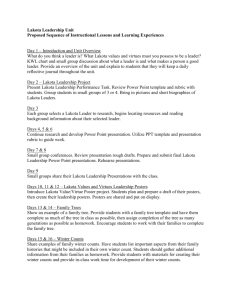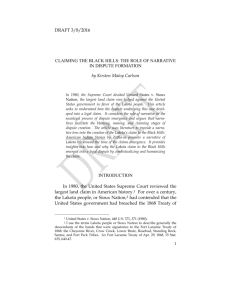Lakota Sioux
advertisement
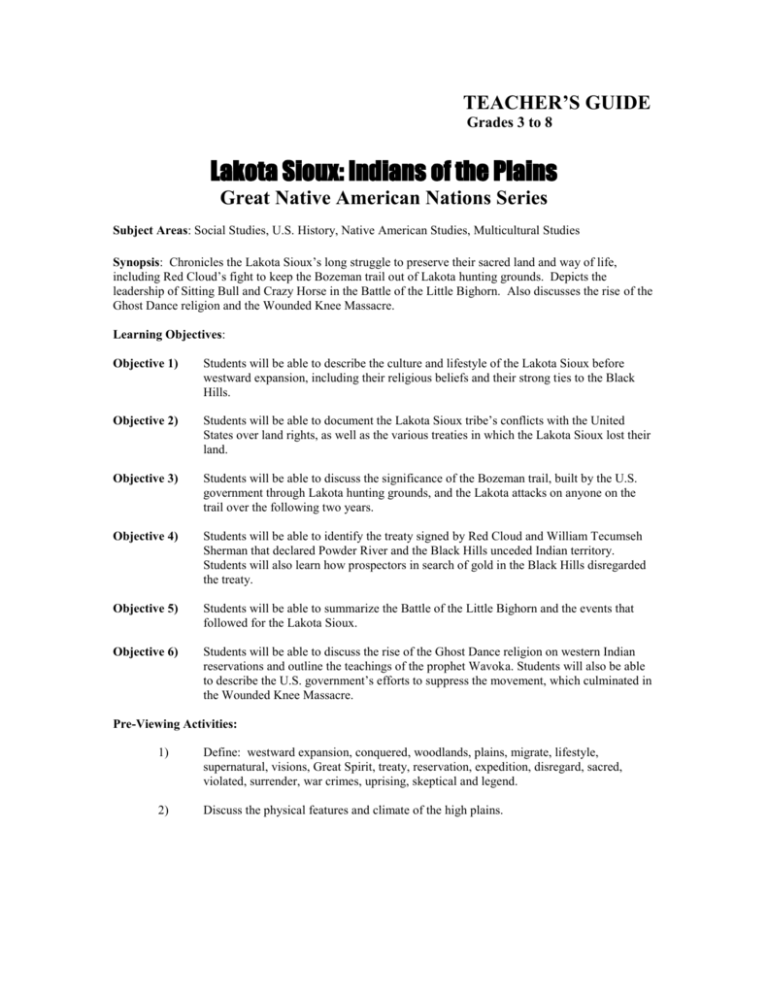
TEACHER’S GUIDE Grades 3 to 8 Lakota Sioux: Indians of the Plains Great Native American Nations Series Subject Areas: Social Studies, U.S. History, Native American Studies, Multicultural Studies Synopsis: Chronicles the Lakota Sioux’s long struggle to preserve their sacred land and way of life, including Red Cloud’s fight to keep the Bozeman trail out of Lakota hunting grounds. Depicts the leadership of Sitting Bull and Crazy Horse in the Battle of the Little Bighorn. Also discusses the rise of the Ghost Dance religion and the Wounded Knee Massacre. Learning Objectives: Objective 1) Students will be able to describe the culture and lifestyle of the Lakota Sioux before westward expansion, including their religious beliefs and their strong ties to the Black Hills. Objective 2) Students will be able to document the Lakota Sioux tribe’s conflicts with the United States over land rights, as well as the various treaties in which the Lakota Sioux lost their land. Objective 3) Students will be able to discuss the significance of the Bozeman trail, built by the U.S. government through Lakota hunting grounds, and the Lakota attacks on anyone on the trail over the following two years. Objective 4) Students will be able to identify the treaty signed by Red Cloud and William Tecumseh Sherman that declared Powder River and the Black Hills unceded Indian territory. Students will also learn how prospectors in search of gold in the Black Hills disregarded the treaty. Objective 5) Students will be able to summarize the Battle of the Little Bighorn and the events that followed for the Lakota Sioux. Objective 6) Students will be able to discuss the rise of the Ghost Dance religion on western Indian reservations and outline the teachings of the prophet Wavoka. Students will also be able to describe the U.S. government’s efforts to suppress the movement, which culminated in the Wounded Knee Massacre. Pre-Viewing Activities: 1) Define: westward expansion, conquered, woodlands, plains, migrate, lifestyle, supernatural, visions, Great Spirit, treaty, reservation, expedition, disregard, sacred, violated, surrender, war crimes, uprising, skeptical and legend. 2) Discuss the physical features and climate of the high plains. Post-Viewing Discussion: 1) When did the Lakota Sioux settle in the Great Plains? How did the tribe adapt to life in this location? What was the special significance of the bison in Lakota life and religion? What was the significance of the Black Hills? 2) What was Red Cloud’s response to the U.S. government’s request for permission to build the Bozeman Trail through Lakota hunting grounds? Why did the United States want to build the road? Did the United States honor Red Cloud’s decision? How did the Lakota respond to this? 3) Under what conditions did Red Cloud agree to make a treaty with William Tecumseh Sherman? What agreements were made in this treaty? In what specific ways did both the United States and the Lakota Sioux break the agreements of this treaty? 4) Who participated in the Battle of the Little Bighorn? Who won the battle? What happened to the Lakota Sioux after the battle? What happened to Crazy Horse after the battle? Where did Sitting Bull lead his followers? Why did they eventually return? 5) What were the basic beliefs of the Ghost Dance Religion? What was the purpose of the Ghostdancers’ ghost shirts? Why do you think the Ghost Dance Religion spread so rapidly? Why was the United States government concerned about the movement? What actions were taken by the United States government to prevent an uprising associated with the Ghost Dancers? 6) What happened at the Wounded Knee Massacre? How did this impact the followers of the Ghost Dance religion? How did this impact the Lakota Sioux tribe as a whole? Additional Activities: 1) Have students write the story of the Battle of the Little Bighorn from the point of view of Crazy Horse, Sitting Bull or George Armstrong Custer. Guide students to relate their feelings and expectations before and after the battle. 2) Hold a debate on whether the Black Hills Mountains should have been opened for mining or left alone because it is a sacred site to the Lakota Sioux. Divide the class into two, assigning each half to a position on the debate. After groups have brainstormed arguments to support their positions, give both groups an opportunity to present their ideas. Related New Dimension Media Titles: Great Native American Leaders Series Native Americans Before Columbus Series More than Bows and Arrows Legacy of the Mound Builders Mesa Verde National Park FOR INFORMATION, OR TO ORDER CONTACT: NEW DIMENSION MEDIA A QUESTAR COMPANY www.ndmquestar.com 680 N. Lake Shore Drive, Suite 900, Chicago, IL 60611 800.288.4456
